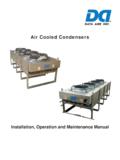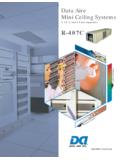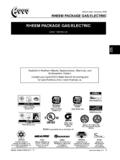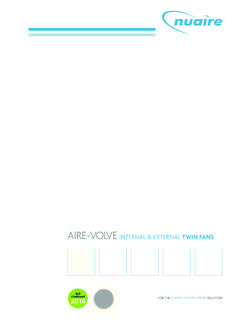Transcription of Flaring - World Bank
1 Flaring Q u e s t i o n s + A n s w e r sSecond EditionFLARING: QUESTIONS + ANSWERSS econd EditionWriter: Robert D. BottCopyright 2007 by the Canadian Centre for Energy Information, Cataloguing In Publications DataMain entry under title: Flaring Questions + Answers1. Gas industry Canada. I. Bott, Robert, 1945- II Canadian Centre for Energy InformationISBN 1-894348-18-4 ABOUT THIS PUBLICATIONF laring Questions + Answers, a companion publication to Sour Gas Questions + Answers, is produced by the Centre for Energy to explain Flaring , venting and incineration of natural gas in Canada. Although some sour gas issues are also Flaring issues, the majority of Flaring involves sweet gas containing little or no hydrogen sulphide (H2S). For a more complete understanding of Flaring and sour gas, readers are urged to consult both documents and the oil and natural gas section of Sources for further information are included at the back of each Questions + Answers has been updated and expanded from the original version published in 2000.
2 It provides more information about new technologies and operating methods that have substantially reduced the amount of Flaring and venting in the Canadian upstream and midstream petroleum industry. Sections on emissions and research have been expanded and all statistics, technical information and illustrations have been reviewed and updated as Brown and James vaughanAlberta Energy and Utilities BoardRandy DobkoAlberta EnvironmentBryan GormleyCanadian Gas AssociationRichard NelsonAlberta Energy Research InstituteLynne PatenaudeEnvironment CanadaSteve Simons and Richard SlocombBritish Columbia Oil and Gas CommissionJohn SquarekCanadian Association of Petroleum ProducersCathy Tuleck Alberta EnergyNOTE: Special terms used in the oil and gas industry are usually defined in context within one page of where they first appear.
3 A glossary of industry terms is included in Our Petroleum Challenge and posted in the oil and natural gas glossary on the Centre for Energy portal An overview about the potential environmental impacts of the oil and gas industry is also posted in the oil and natural gas section of the the Canadian Centre for Energy Information has endeavoured to provide accurate and current information within this publication, the Centre for Energy and the volunteer reviewers do not: make any warranty or representation, expressed or implied with respect to accuracy, completeness or usefulness of the information contained within this booklet; assume any responsibility or liability to any party for any damages resulting from the negligence of the Centre for Energy in preparation of any information, method or process described in this publication; or endorse any product, service or process which may be described or implied within this may use the contents of this booklet for personal study or review only.
4 Educators and students are permitted to reproduce portions of the booklet, unaltered, with acknowledgement to the Canadian Centre for Energy Information. Copyright to all photographs and illustrations belongs to the organizations and individuals noted as sources on the images. For other usage information, please contact the Canadian Centre for Energy Information in in Flaring and venting practicesFlaring burning natural gas in an open flame has long been part of the process for producing marketable natural gas and crude oil in the petroleum industry. However, Flaring wastes potentially valuable resources and produces emissions that can affect human health, livestock and the environment. As a result, there has been a growing movement, in Canada and internationally, to reduce Flaring .
5 Government, industry and stakeholder groups in Alberta have been leaders in this initiative. From 1998 to 2005, the total amount of Flaring in Alberta was reduced by 54 per cent despite strong growth in natural gas exploration and production. Among the key reasons for the sharp reduction in Flaring : commitments by industry and regulators to address environmental impacts, meet public expectations and conserve resources economic incentives due to higher natural gas prices new technologies to produce, process, transport and utilize natural gas new methods to dispose of unmarketable natural gasVenting direct release of natural gas into the atmosphere has also been reduced substantially, for similar reasons. In Alberta, the amount of reported venting was halved between 2000 and 2005.
6 Wherever possible, industry today strives to contain natural gas and deliver it to customers. If this is impractical, the natural gas may be disposed of or utilized in other ways: burned in properly designed incinerators, which are generally more efficient than flares used to generate electricity and steam injected underground 1 Local distribution companies also add tiny amounts of a substance called mercaptan to the natural gas and propane used by consumers. Mercaptan gives retail natural gas and propane its characteristic odour so that even the smallest leaks are easily noticed. Methane, ethane and propane are odourless. About natural gasThe natural gas that is shipped through transmission pipelines and delivered to consumers consists almost entirely of methane (CH4), the simplest hydrocarbon, plus small amounts of ethane (C2H6) and propane (C3H8), carbon dioxide (CO2) and nitrogen (N2).
7 1 However, natural gas is seldom found in such pure form underground except natural gas from coal, which is almost pure methane. Raw natural gas is typically a mixture that may also include butane, pentane and heavier hydrocarbons as well as substances such as carbon dioxide (CO2), hydrogen sulphide (H2S), water vapour and/or helium (He). These substances are removed at processing plants before the natural gas is pipelined to customers. If natural gas contains H2S, it is called sour gas. H2S has a strong rotten egg odour even in very low concentrations and is toxic at higher concentrations. Nearly one-third of the natural gas produced in Canada is sour. Crude oil often contains some natural gas. Known as associated gas or solution gas, this natural gas is dissolved in the oil in pressurized underground reservoirs, but bubbles out of the oil like carbonation in beverages when the oil is brought to the surface where the pressure is reduced.
8 Solution gas accounts for about nine per cent of Canadian natural gas production. If this gas contains H2S, it is called sour solution gas. Natural gas is also found in coal seams. This gas is known as coalbed methane (CBM) or natural gas from coal (NGC). This gas is generally sweet, containing little or no f L a r i n g Q u e s t i o n s + a n s w e r s n d e d i t i o nPhoto courtesy of Junewarren PublishingContentsseCtion 1: ReCoVeRinG MoRe MARketAble nAtuRAl GAs 4 Why is some natural gas flared, incinerated or vented? 4 What is Flaring ? 5 What are incinerators? 5 What is venting? 5 What is injection? 6 What are microturbines? 6 How much has natural gas conservation improved?seCtion 2: FACilities And Methods 8 How have Flaring and venting been reduced during well tests?
9 9 How have Flaring and venting of solution gas been reduced? 10 How have processing plants reduced Flaring and venting? 10 How have other petroleum facilities reduced Flaring and venting?seCtion 3: eMissions And eFFeCts 12 What is emitted from Flaring , incineration and venting? 13 How do emissions affect humans, animals and the environment? 14 Who regulates facilities and emissions?seCtion 4: ReseARCh And Continuous iMpRoVeMent 16 Why has conservation improved? 17 What research has been conducted into Flaring , incineration and venting? 18 Will improvements continue? FoR FuRtheR inFoRMAtion 19 Publications 20 Websites 21 Key DefinitionsChARts, tAbles And illustRAtions 4 Natural gas flared and incinerated in Canada, 2005 6 Flaring from Alberta upstream oil and gas sources 6 Venting from Alberta upstream oil and gas sources 9 Solution gas Flaring in Alberta 9 Crude oil battery 12 Sources of greenhouse gas emissions in the Canadian upstream oil and gas industry 14 Decision tree 16 Deep well injectionf L a r i n g Q u e s t i o n s + a n s w e r s n d e d i t i o n Section 1 Recovering More Marketable Natural Gas Photo courtesy of Junewarren PublishingMore than 98 Per Cent oF the natUraL GaS ProDUCeD In CanaDa IS ProCeSSeD to reMoVe any IMPUrItIeS anD then ShIPPeD By PIPeLIne to CUStoMerS or USeD WIthIn the oIL anD GaS InDUStry.
10 HoWeVer, SoMe natUraL GaS IS not eConoMICaL to ProCeSS anD ShIP DUe to SMaLL VoLUMeS or LaCK oF PIPeLIne ConneCtIonS. there are aLSo oPeratIonaL anD SaFety reaSonS Why SoMe natUraL GaS Cannot Be SoLD or USeD. the UnMarKetaBLe GaS May Be BUrneD In FLareS or, In SoMe CIrCUMStanCeS, reLeaSeD DIreCtLy Into the atMoSPhere. other DISPoSaL oPtIonS are InCIneratIon or InJeCtInG the GaS UnDerGroUnD. f L a r i n g Q u e s t i o n s + a n s w e r s n d e d i t i o n f L a r i n g Q u e s t i o n s + a n s w e r s n d e d i t i o nPhoto courtesy of Questor technology inc. IncineratorWhy is some natural gas flared, vented or incinerated? The oil and gas industry avoids Flaring and venting natural gas whenever possible.

















